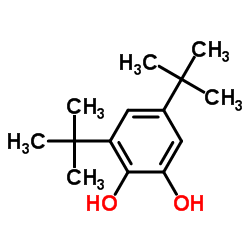A novel tripodal ligand containing three different N-heterocyclic donor functions and its application in catechol dioxygenase mimicking.
Marit Wagner, Christian Limberg, Thomas Tietz
Index: Chemistry 15(22) , 5567-76, (2009)
Full Text: HTML
Abstract
We describe a novel chiral ligand, L, in which three different N-donor functions are linked to a methoxymethine unit: a methylpyrazole derivative, a methylimidazole unit, and a pyridyl residue. Complexes with FeCl(2), FeBr(2), and FeCl(3) have been synthesized and fully characterized, including with respect to their molecular structures. While in combination with FeCl(3) L coordinates in a tripodal fashion, with FeX(2) (X = Cl, Br) it binds only through two functions and the pyridyl unit remains dangling. For potential modelling of intradiol and extradiol catechol dioxygenase reactivity, the complexes [LFeCl(2)], 1, and [LFeCl(3)], 3, have been treated with 3,5-di-tert-butylcatechol, triethylamine, and O(2). Both complexes yielded similar results in such investigations, since the LFe(II)-catecholate complex reacts with O(2) through one-electron oxidation in the first step. Employing 3 in acetonitrile solution, intradiol cleavage occurred, although the undesired quinone was formed as the main product. If reagents were added (NaBPh(4), H(+)) or reaction conditions were chosen (CH(2)Cl(2) instead of CH(3)CN as the solvent) that made the coordination sphere at the iron centre more accessible for a third substrate donor function, an alternative reaction route, presumably involving O(2) binding at the metal, became more important, which led to extradiol cleavage. In the extreme case (CH(2)Cl(2) as the solvent and with the addition of NaBPh(4)), mainly the extradiol cleavage products were formed; the intradiol products were only observed as side products then and quinone formation became negligible. Protonated base functions in the second coordination sphere increased the efficiency of extradiol cleavage only slightly. The obtained results are in line with current understanding of the function of intradiol/extradiol dioxygenases.
Related Compounds
| Structure | Name/CAS No. | Molecular Formula | Articles |
|---|---|---|---|
 |
3,5-Di-t-butylcatechol
CAS:1020-31-1 |
C14H22O2 |
|
Catechol oxidase activity of a series of new dinuclear coppe...
2008-08-18 [Inorg. Chem. 47(16) , 7083-93, (2008)] |
|
3,5-Di-t-butyl catechol is a potent human ryanodine receptor...
2012-07-01 [Pharmacol. Res. 66(1) , 80-7, (2012)] |
|
Chemistry of singlet oxygen--48. Isolation and structure of ...
1987-09-01 [Photochem. Photobiol. 46(3) , 325-30, (1987)] |
|
3,5-di-t-butylcatechol (DTCAT) as an activator of rat skelet...
2005-02-01 [Biochem. Pharmacol. 69(3) , 485-91, (2005)] |
|
Design and synthesis of new biomimetic materials.
2000-04-01 [J. Inorg. Biochem. 79(1-4) , 93-6, (2000)] |